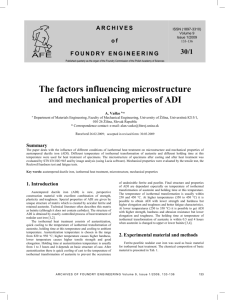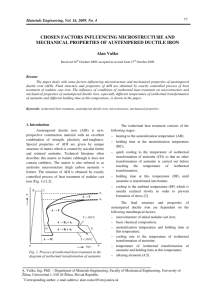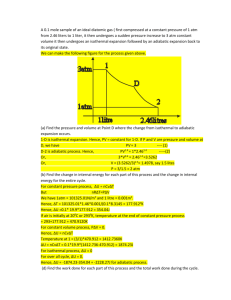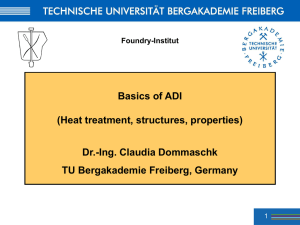microstructure and mechanical properties of austempered ductile iron
advertisement
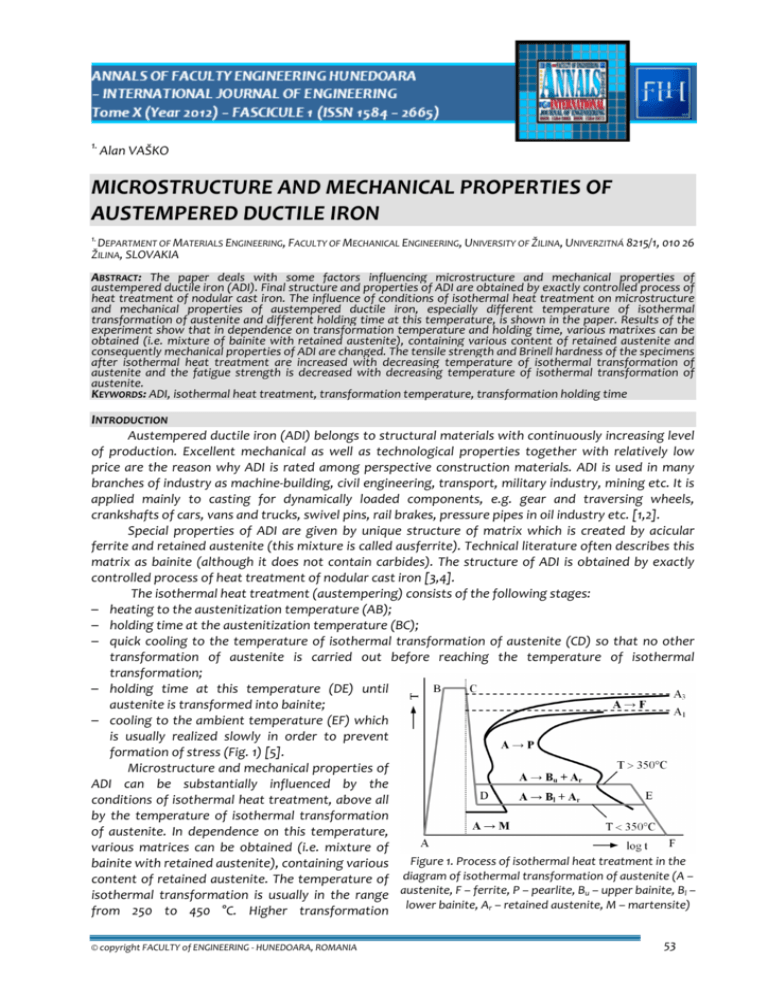
1. Alan VAŠKO MICROSTRUCTURE AND MECHANICAL PROPERTIES OF AUSTEMPERED DUCTILE IRON 1. DEPARTMENT OF MATERIALS ENGINEERING, FACULTY OF MECHANICAL ENGINEERING, UNIVERSITY OF ŽILINA, UNIVERZITNÁ 8215/1, 010 26 ŽILINA, SLOVAKIA ABSTRACT: The paper deals with some factors influencing microstructure and mechanical properties of austempered ductile iron (ADI). Final structure and properties of ADI are obtained by exactly controlled process of heat treatment of nodular cast iron. The influence of conditions of isothermal heat treatment on microstructure and mechanical properties of austempered ductile iron, especially different temperature of isothermal transformation of austenite and different holding time at this temperature, is shown in the paper. Results of the experiment show that in dependence on transformation temperature and holding time, various matrixes can be obtained (i.e. mixture of bainite with retained austenite), containing various content of retained austenite and consequently mechanical properties of ADI are changed. The tensile strength and Brinell hardness of the specimens after isothermal heat treatment are increased with decreasing temperature of isothermal transformation of austenite and the fatigue strength is decreased with decreasing temperature of isothermal transformation of austenite. KEYWORDS: ADI, isothermal heat treatment, transformation temperature, transformation holding time INTRODUCTION Austempered ductile iron (ADI) belongs to structural materials with continuously increasing level of production. Excellent mechanical as well as technological properties together with relatively low price are the reason why ADI is rated among perspective construction materials. ADI is used in many branches of industry as machine‐building, civil engineering, transport, military industry, mining etc. It is applied mainly to casting for dynamically loaded components, e.g. gear and traversing wheels, crankshafts of cars, vans and trucks, swivel pins, rail brakes, pressure pipes in oil industry etc. [1,2]. Special properties of ADI are given by unique structure of matrix which is created by acicular ferrite and retained austenite (this mixture is called ausferrite). Technical literature often describes this matrix as bainite (although it does not contain carbides). The structure of ADI is obtained by exactly controlled process of heat treatment of nodular cast iron [3,4]. The isothermal heat treatment (austempering) consists of the following stages: – heating to the austenitization temperature (AB); – holding time at the austenitization temperature (BC); – quick cooling to the temperature of isothermal transformation of austenite (CD) so that no other transformation of austenite is carried out before reaching the temperature of isothermal transformation; – holding time at this temperature (DE) until austenite is transformed into bainite; – cooling to the ambient temperature (EF) which is usually realized slowly in order to prevent formation of stress (Fig. 1) [5]. Microstructure and mechanical properties of ADI can be substantially influenced by the conditions of isothermal heat treatment, above all by the temperature of isothermal transformation of austenite. In dependence on this temperature, various matrices can be obtained (i.e. mixture of bainite with retained austenite), containing various Figure 1. Process of isothermal heat treatment in the content of retained austenite. The temperature of diagram of isothermal transformation of austenite (A – isothermal transformation is usually in the range austenite, F – ferrite, P – pearlite, Bu – upper bainite, Bl – from 250 to 450 °C. Higher transformation lower bainite, Ar – retained austenite, M – martensite) © copyright FACULTY of ENGINEERING ‐ HUNEDOARA, ROMANIA 53 ANNALS OF FACULTY ENGINEERING HUNEDOARA – International Journal Of Engineering temperatures (350 to 450 °C) lead to lower strength and hardness but higher elongation and toughness and better fatigue characteristics. Lower transformation temperatures (250 to 350 °C) lead to higher strength, hardness and abrasion resistance but lower elongation and toughness [6]. The influence of temperature of isothermal transformation of austenite and holding time at this temperature on microstructure and mechanical properties of ADI is studied in the paper. EXPERIMENTAL MATERIAL AND METHODS The influence of conditions of isothermal heat treatment on microstructure and mechanical properties of austempered ductile iron was searched on several sets of specimens which were different in temperature of isothermal transformation of austenite and holding time at this temperature. Experimental material was melted in the electric induction furnace ISTOL. The basic charge was formed by pig iron, steel scrap and additives for the control of chemical composition. FeSiMg7 modifier was used for modification and FeSi75 inoculant was used for inoculation. Ferrite‐pearlitic nodular cast Table 1. Chemical composition of basic material (after casting) iron was used as basic material for Chemical C Si Mn S P Cu Ni Mg element isothermal heat treatment. Content Chemical composition of the basic (weight %) 2.78 4.69 0.49 0.017 0.050 0.92 1.10 0.044 material is presented in Tab. 1. The heat treatment consisted of austenitization and following isothermal transformation. The austenitization temperature was 920 °C and the holding time at this temperature was 30 minutes. The isothermal transformation of austenite was realized in AS 140 salt bath at the temperatures 420, 380, 320 a 250 °C and the holding time at this temperature was from 30 to 300 minutes (by 30 min.) [7]. The metallographic analysis of specimens of basic material (after casting) and specimens after isothermal heat treatment was made by the light metallographic microscope Neophot 32. The microstructure was evaluated by STN EN ISO 945 (STN 42 0461) and by image analysis (using Lucia software) [8‐10]. The tensile test was made by STN EN 10002‐1 by means of the testing equipment ZDM 30 with loading range F = 0 to 50 kN. The Brinell hardness test was made by STN EN ISO 6506‐1 by means of the testing equipment CV‐3000LDB with the hardmetal ball indenter of a diameter D = 5 mm pressed into the surface of specimens under the load F = 7355 N (750 kp) [11]. The fatigue tests were made by STN 42 0362 at high‐frequency sinusoidal cyclic push‐pull loading (frequency f ≈ 20 kHz, load ratio R = –1, temperature T = 20 ± 5 °C) using the ultrasonic testing equipment KAUP‐ZU and the testing procedures [12]. EXPERIMENTAL RESULTS ‐ METALLOGRAPHIC ANALYSIS Results of evaluation of microstructure of specimens after casting (basic material) and after isothermal heat treatment are shown in Tab. 2 (evaluation by etalons) and Tab. 3 (evaluation by image analysis). Table 2. Evaluation of microstructure From the microstructural point of view of specimens by etalons the basic material (after casting) is ferrite‐ Microstructure Specimen pearlitic nodular cast iron (Fig. 2) with 57% by STN EN ISO 945 (42 0461) content of ferrite in a matrix. Graphite occurs basic 80 % VI 6/7 + 20 % V 6/7 Fe 55 material only in a perfectly‐nodular (80%) and upper bainite + imperfectly‐nodular (20%) shape. The size of 420 °C/ 60’ 80 % VI 6/7 + 20 % V 6/7 retained austenite 380 °C/ 60’ graphite is within 15 and 60 μm, count of 320 °C/ 60’ lower bainite + 80 % VI 6/7 + 20 % V 6/7 graphitic nodules is 205 mm‐2 and circularity 250 °C/ 60’ retained austenite (shape factor) is 0.80. Specimen basic material 420 °C/ 60’ 380 °C/ 60’ 320 °C/ 60’ 250 °C/ 60’ Table 3. Evaluation of microstructure of specimens by image analysis Circularity Content of ferrite Content of retained Count of graphitic (shape factor) (%) austenite (%) nodules (mm‐2) 205.4 0.80 57 – 192.6 0.76 – 25.2 198.1 0.82 – 38.8 198.1 0.80 – 32.5 222.0 0.80 – 30.0 54 Tome X (Year 2012). Fascicule 1. ISSN 1584 – 2665 ANNALS OF FACULTY ENGINEERING HUNEDOARA – International Journal Of Engineering The color etching by sodium chromate was used for the differentiation of structural phases (ferrite, pearlit and graphite) as well as for the visualization of segregation of main alloying elements (silicium and manganese) dissolved in ferrite. The content of silicium is the highest around graphitic nodules and the lowest on the boundaries of eutectic cells – it is possible to observe the change of colour from brown to white (Fig. 2b). The content of manganese has the opposed course. a) non‐etched b) etched by sodium chromate Figure 2. Microstructure of basic material (after casting) – ferrite‐pearlitic nodular cast iron a) 420°C/ 60’ – upper bainite and retained austenite b) 250°C/ 60’ – lower bainite and retained austenite Figure 3. Microstructure of ADI (after isothermal heat treatment), etched by 3 % Nital After isothermal heat treatment ADI was obtained. Matrix is created by acicular ferrite and retained austenite (ausferrite) which is often described as bainite. The specimens after isothermal heat treatment with the temperature of isothermal transformation of austenite 420 and 380 °C have a matrix created by upper bainite and retained austenite (Fig. 3a). The specimens after isothermal heat treatment with the temperature of isothermal transformation of austenite 320 and 250 °C have a matrix created by lower bainite and retained austenite (Fig. 3b). The content of retained austenite, evaluated by the X‐ray phase analysis (Fig. 4), is decreased with decreasing temperature of isothermal transformation of austenite and it is also slightly decreased with increasing holding time in all sets of specimens. The shape, size and count of graphitic Figure 4. Evaluation of retained austenite nodules in the specimens after isothermal heat by X‐ray phase analysis treatment are not changed in comparison with the specimen of basic material (after casting) (Tab. 3). The color etching by Beraha‐Martenzit was used for eventual differentiation of bainite and martensite but the presence of martensite was not proved. © copyright FACULTY of ENGINEERING ‐ HUNEDOARA, ROMANIA 55 ANNALS OF FACULTY ENGINEERING HUNEDOARA – International Journal Of Engineering EXPERIMENTAL RESULTS ‐ MECHANICAL PROPERTIES The changes in microstructure of specimens after Table 4. Mechanical properties of specimens after casting and after isothermal heat isothermal heat treatment caused a change in mechanical treatment properties (Tab. 4). Rm HBW σc Specimen Tensile strength of the basic material (ferrite‐ (MPa) 5/750/10 (MPa) pearlitic nodular cast iron) is 722 MPa, hardness of the basic material 722 263 390 basic material is 263 HB. The isothermal heat treatment 420 °C/ 60’ 980 359 378 380 °C/ 60’ 1040 368 361 induced considerable improvement of tensile strength 320 °C/ 60’ 1164 423 328 and hardness in comparison with the basic material. The 250 °C/ 60’ 1551 471 276 tensile strength and hardness of the specimens after isothermal heat treatment are increased with decreasing temperature of isothermal transformation of austenite (Fig. 5a). The hardness is decreased with increasing holding time at the temperature of isothermal transformation of austenite in all sets of specimens. Fatigue strength of the basic material is about 390 MPa. The isothermal heat treatment induced a decrease of fatigue properties in comparison with the basic material. Fatigue endurance of the specimens after isothermal heat treatment is decreased with decreasing temperature of isothermal transformation of austenite (Fig. 5b). The increase of tensile strength and hardness with decreasing temperature of isothermal transformation of austenite is caused by a change of matrix from upper bainite to lower bainite. The decrease of fatigue strength with decreasing temperature of isothermal transformation of austenite is due to the same change of microstructure. a) tensile strength b) fatigue strength Figure 5. Comparison of mechanical properties The measured values of tensile strength, hardness and fatigue strength correspond to results of similar experiments abroad, for example [13,14]. CONCLUSIONS Final microstructure and consequently also mechanical properties of casts from ADI are markedly dependent on the temperature of isothermal transformation of austenite and holding time at this temperature. Their influence on the microstructure and mechanical properties of ADI can be summarized in following points: – the specimens with higher temperature of isothermal transformation of austenite have the matrix consisted of upper bainite and retained austenite and the specimens with lower temperature of isothermal transformation of austenite have the matrix consisted of lower bainite and retained austenite; – the content of retained austenite is decreased with decreasing temperature of isothermal transformation of austenite as well as with increasing holding time at this temperature; – the shape, size and count of graphitic nodules are not changed in dependence on the temperature of isothermal transformation of austenite and in dependence on the holding time at this temperature; – the tensile strength and hardness of the specimens are increased with decreasing temperature of isothermal transformation of austenite, but the elongation and toughness is decreased; – the hardness of the specimens is decreased with increasing holding time at the temperature of isothermal transformation; 56 Tome X (Year 2012). Fascicule 1. ISSN 1584 – 2665 ANNALS OF FACULTY ENGINEERING HUNEDOARA – International Journal Of Engineering – the fatigue strength is decreased with decreasing temperature of isothermal transformation of austenite. The choice of temperature of isothermal transformation of austenite and holding time at this temperature depends on a required combination of mechanical properties. ACKNOWLEDGMENTS This work has been supported by the Culture and Educational Grant Agency of the Ministry of Education of Slovak Republic, grant No. 220‐009ŽU‐4/2010. REFERENCES [1] [2] [3] [4] [5] [6] [7] [8] [9] [10] [11] [12] [13] [14] Dorazil, E.: Austempered Ductile Iron – ADI, Slevarenstvi, 41 (4), p. 181‐183, 1993. (in Czech) Věchet, S.; Kohout, J.; Klakurková, L.: Fatigue Properties of Austempered Ductile Iron in Dependence of Transformation Temperature, Materials Science (Medziagotyra), 14 (4), p. 324‐327, 2008. http://www.aditreatments.com Skočovský, P.; Bokůvka, O.; Konečná, R.; Tillová, E.: Material Science for Specializations of Mechanical Engineering, Žilina, EDIS, 2006. (in Slovak) Gedeonová, Z.; Jelč, I.: Metallurgy of cast irons, Košice, HF TU, 2000. (in Slovak). Skočovský, P.; Podrábský, T.: Graphitic cast irons, Žilina, EDIS, 2005. (in Slovak). Vaško, A.; Kopas, P. Analysis of the factors influencing microstructure and mechanical properties of austempered ductile iron, In: Transcom 2009, Žilina, p. 221‐224, 2009. Skočovský, P.; Vaško, A.: Quantitative evaluation of structure of cast irons, Žilina, EDIS, 2007. (in Slovak) Belan, J.: Structural analyses of advanced material for aerospace industry, Materials Science (Medžiagotyra), 14 (4), p. 315‐318, 2008. Tillová, E.; Chalupová, M.; Hurtalová, L.: Evolution of the Fe‐rich phases in Recycled AlSi9Cu3 Cast Alloy During Solution Treatment, Communications, 12 (4) p. 95‐101, 2010. Vaško, M.; Sága, M.; Dunajčan, S.: Proposition of the Computational Algorithm for Elasto‐plastic Analysis of the Beam Element, Metalurgija/Metalurgy, 49 (2), p. 577‐582, 2010. Nicoletto, G.; Bokůvka, O.; Collini, L.; Kopas, P.: Fatigue resistance in the very high‐cycle regime, Transaction of FAMENA, 29 (1), p. 9‐16, 2005. Salman, S.; Findik, F.; Topuz, P.: Effects of Various Austempering Temperatures on Fatigue Properties in Ductile Iron, Materials and Design, 28 (7), p. 2210‐2214, 2007. Kim Y. J.; Shin H.; Park H.; Lim J. D.: Investigation into Mechanical Properties of Austempered Ductile Cast Iron (ADI) in Accordance with Austempering Temperature, Materials Letters, 62 (3), p. 357‐360, 2008. ANNALS OF FACULTY ENGINEERING HUNEDOARA – INTERNATIONAL JOURNAL OF ENGINEERING copyright © UNIVERSITY POLITEHNICA TIMISOARA, FACULTY OF ENGINEERING HUNEDOARA, 5, REVOLUTIEI, 331128, HUNEDOARA, ROMANIA http://annals.fih.upt.ro © copyright FACULTY of ENGINEERING ‐ HUNEDOARA, ROMANIA 57



